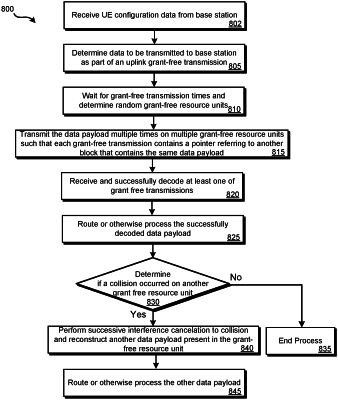| CPC H04W 72/02 (2013.01) [H04J 11/004 (2013.01); H04L 1/189 (2013.01); H04W 72/044 (2013.01); H04W 72/1263 (2013.01); H04W 84/042 (2013.01)] | 18 Claims |

|
1. A method for performing grant-free uplink transmissions, the method comprising:
determining, by a first user equipment (UE), data that is to be transmitted using a grant-free uplink transmission to a base station of a cellular network;
selecting, by the first UE, a first grant-free resource block, wherein:
a plurality of grant-free resource blocks define a plurality of subcarrier frequencies and a plurality of timeslots for data to be transmitted to the base station of the cellular network without a reservation by the first UE;
selecting, by the first UE, a second grant-free resource block;
selecting, by the first UE, a third grant-free resource block;
transmitting, by the first UE, a first grant-free transmission that comprises: 1) a data payload; 2) a first pointer; and 3) a second pointer, wherein:
the first pointer refers to the second grant-free resource block; and
the second pointer refers to the third grant-free resource block;
receiving, by the base station, the first grant-free transmission transmitted by the first UE on the first grant-free resource block;
detecting, by the base station, a collision on the second grant-free resource block, wherein the collision results from a second grant-free transmission being received during a same timeslot and a same frequency as a third grant-free transmission from a second UE distinct from the first UE; and
based on the first pointer of the first grant-free transmission, performing interference cancelation to subtract at least a portion of the first grant-free transmission from the collision to reconstruct the third grant-free transmission transmitted by the second UE at the second grant-free resource block.
|